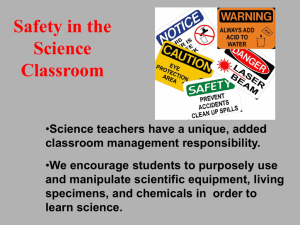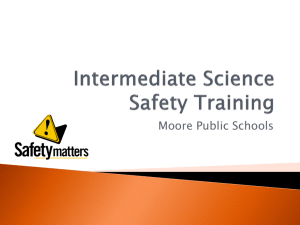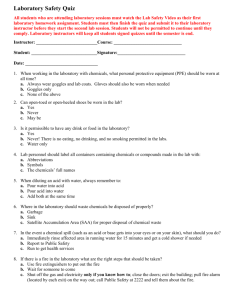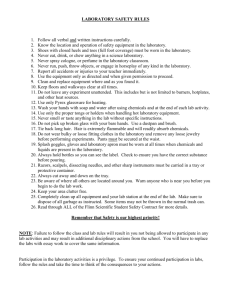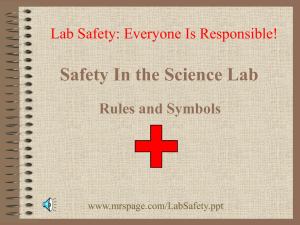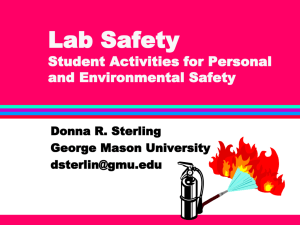Laboratory Safety: It's not a matter of if, but rather, when
advertisement
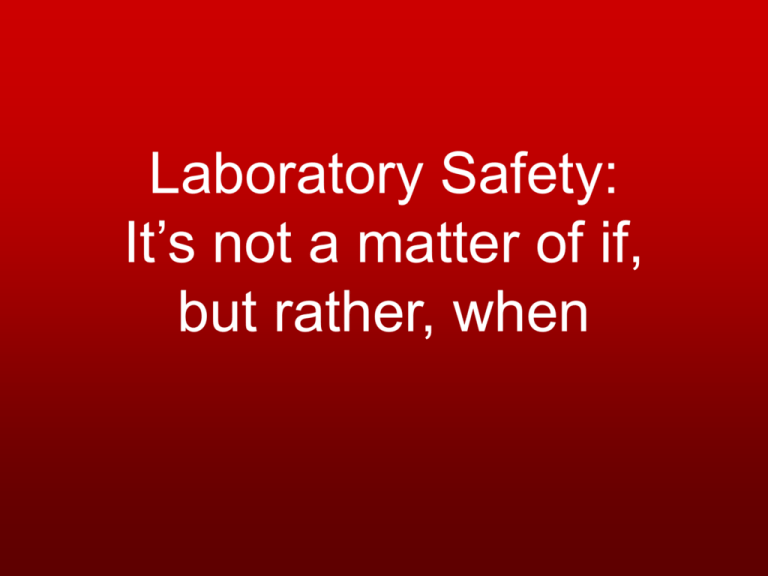
Laboratory Safety: It’s not a matter of if, but rather, when Think Fast 1. How many students should be in a science laboratory? 2. What does MSDS stand for? 3. What has MSDS? 4. What basic safety equipment should be in every lab? 5. What kind of fire extinguishers should most labs have? 6. When should goggles be worn? 7. What kind of goggles should be worn? 8. What are the 4 classes of chemical hazards? 9. What is a chemical hygiene plan? Think Fast 1. 2. 3. 4. 5. 6. 7. 8. How many students should be in a science laboratory? 24 What does MSDS stand for? Material Data Safety Sheets What has MSDS? All chemical products What basic safety equipment should be in every lab? Fire extinguisher, fire blanket, shower, eye wash What kind of fire extinguishers should most labs have? ABC triclass chemical When should goggles be worn? Any time fire or chemicals are used What kind of goggles should be worn? ANSI Z87 (American National Standards Institute) What are the 4 classes of chemical hazards? flammability, corrosivity, toxicity, reactivity 9. What is a chemical hygiene plan? A comprehensive plan for identifying and dealing with chemical hazards including lab rules, procedures, chemical procurement, storage, distribution, environmental monitoring, housekeeping, maintenance, inspections, records, signs & labeling, spills & accidents, training & information, waste disposal and safety recommendations. Things you should do before the students arrive. • Check for basic safety equipment (extinguishers, blankets, showers, goggles, eye wash). • Check for mercury thermometers. • Organize chemicals appropriately. • Talk to administration/dept. chair about mystery substances. • Make sure chemicals are secure from students. • Find out where the nearest phone is. • Familiarize yourself with the MSDS for the chemicals you will have students use. • Ask about the school’s chemical hygiene plan. • Check the ventilation of your room. • If you use bases, make sure you have acetic acid available; acids, sodium bicarbonate; bacteria or DNA, 5% disinfectant or 10% bleach. • Know where your master cut-off switches/valves are Flinn Catalog • When you have an official teaching position & school address, request a Flinn catalog: Flinn Scientific P.O. Box 219 Batavia, IL 60510-0219 http://www.flinnsci.com/ Science & Safety: Making the Connection Chemical Storage Cases • The authors talk about teaching by means of “tricks of the trade” vs. thoughtful practice. What is the difference? • What is a case? How is it different from a case study? • What do the authors mean by context? • How does a case-based approach to exploring teaching relate to or reflect constructivism? • What are open and closed cases? Case 11.2 • In what ways was Ms. Lendell an effective mentor? • How can a student teacher develop his/her own style with a “overly supportive” cooperating teacher? • Check out Julie Guess-Newsome’s prioritized list of teaching concerns (p. 282). What is your reaction to this list? Do you agree that teachers can only work on one thing at a time?
